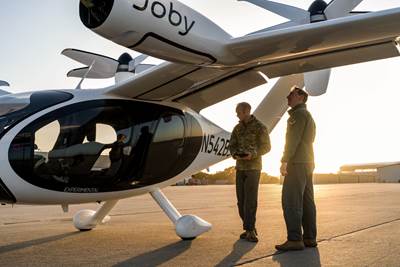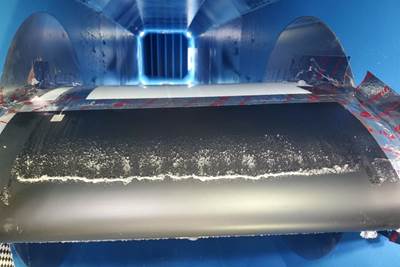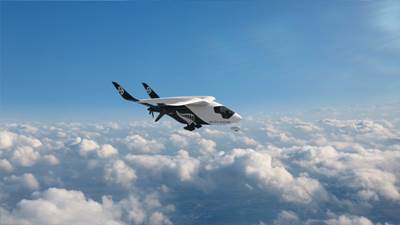Beta Technologies completes first Alia deployment with U.S. DOD
The U.S. Air Force conducted on-base and cross-country mission and performance evaluations of Beta’s composites-intensive CTOL aircraft, hitting key milestones.
Beta Technologies (South Burlington, Vt., U.S.) has concluded its first Alia conventional takeoff and landing (CTOL) aircraft deployment with the U.S. Department of Defense (DOD), which saw the electric aerospace company stationed at Duke Field, Eglin Air Force base (AFB) for 3 months of experimental operations and training with the 413th Flight Test Squadron through the Air Force’s Agility Prime program. This deployment was the next phase of a larger developmental test and evaluation (DT&E) effort being conducted by the U.S. Air Force (USAF) to assess electric aviation’s applicability for DOD missions.
Beta’s Alia aircraft arrived at Duke Field in October 2023 following a more than 1,500 nautical mile mission down the East Coast. During this mission, Alia flew through the Class Bravo airspace of Boston and New York, and reportedly became the first electric aircraft to fly through the Flight Restricted Zone of Washington, D.C. to stop at Joint Base Andrews.
The deployment included Beta’s Alia CTOL electric aircraft, which was used for operational experimentation and USAF pilot and maintenance assessments, and a MobileDome simulator, which the Beta flight test team and USAF pilots used to rehearse flights and practice emergency procedures and served as a key tool for training and immersion for stakeholders and subject matter experts (SMEs). Beta also installed a Level 3 DC fast-charger (350 kilowatts) — the first electric aircraft charging station at a DOD installation. This multimodal charger supported charge needs between flights.
Over the course of the deployment, Beta’s core flight test team worked hand-in-hand with AFWERX, the Air Force’s innovation unit, and the 413th Flight Test Squadron to conduct hands-on experimentation and training with the technology to validate military use cases including critical resupply, cargo delivery and personnel transport. These use cases mirror real operations the USAF has planned for its multitude of theaters. Key milestones of the deployment include:
Air Force-directed operational experimentation and training
Together, Beta and the 413th achieved mission assessments across a broad span of categories, including flight operations, maintenance support and infrared signature characterization. The missions from Duke Field,
which ranged from short sorties to extended missions, averaged approximately $15 in energy per flight.
The 413th Flight Test Squadron also invited numerous local Air Force pilots to participate in electric aircraft training at the MobileDome simulator. These subject matter experts provided input on flight characteristics and ease of learning the platform.
Performed simulated casualty evacuation mission with an electric aircraft
The 413th Flight Test Squadron invited Beta to participate in a simulated casualty evacuation (CASEVAC) scenario with the 41st Rescue Squadron, an active duty Air Force unit based out of Moody AFB in Georgia. The CASEVAC mission was an exercise-style proof of concept with a scenario involving
a simulated patient (rescue randy), ground forces a simulated quick reaction force (QRF) and an HH-60W and Alia aircraft.
In this scenario, the HH-60W transported a simulated casualty from a forward operating base (FOB) to an operating location located in friendly territory, then returned to the FOB with the QRF. The Alia aircraft performed the patient transport to definitive medical care from the operating location, relieving the HH-60W Jolly Green crew, completing what is claimed to be the first CASEVAC and first direct operations mission with USAF for an electric aircraft.
This scenario demonstrates key impacts electric aviation can have on military services, including increase in response time at the FOB. The HH-60 was able to initiate the movement of the QRF sooner than if it had to move the patient to definitive medical care. The decision to transport the patient the total distance in the HH-60W vice stopping at an intermediate location is based on suitable runway availability and availability of an aircraft for transport such as a C-130.
This simulated mission also demonstrated the decrease in resources required via electric aviation. A similar C-130 patient transport requires similar runway length and would require a crew of at least three and approximately $1,600 in fuel. The Alia aircraft accomplished this simulated mission with a crew of two and an energy cost of approximately $5 in electricity.
Executed a maintenance recovery team mission
Alia completed a simulated maintenance recovery team (MRT) mission, delivering maintenance assets for an F-35 Lightning II which landed at Duke Field. Beta’s electric aircraft flew to Tyndall AFB to pick up the simulated part and bring it back to the aircraft in need.
The MRT mission was a demonstration with implications for training, exercise, and operational maintenance responses. The ability to fly an MRT at distances normally relegated to driving opens possibilities for cost and man-hour savings. The cost estimate for a maintenance response of a home-unit based Alia, involving two flight legs, would be approximately $25 in electricity and 1 hour of flight time. A standard F-250, covering the same geographical distance, would cost approximately $45 in fuel and equate approximately 4 hours of driving. A faster response time enables maintenance to be performed same-day and can directly improve downtime for advanced aircraft, resulting in other reduced costs for flying squadrons, such as unexpected lodging and per diem, as well as additional transportation costs to recover a fixed aircraft.
Integrating and growing Beta’s charge network
In addition to regular use of its on-base multimodal DC fast charger at Duke Field, which powered the months-long deployment, the Beta team flew Alia from Duke to Valdosta, Georgia, transiting through Decatur, Georgia, to officially commission the Beta charger at Valdosta Regional Airport. Beta is also validating mobile charging solutions for contingency and austere operating locations.
In addition to the flight test milestones and more technical operational assessments conducted, the data collected from experimentation at Duke Field demonstrates the value of electric aviation within the modern operational environment.
This deployment was a significant next step in a long-standing partnership between Beta and the DOD through its AFWERX Agility Prime Program. Beta first partnered with AFWERX in 2020, and has collaborated with the Air Force and Army through this program, accelerating the development and
adoption of electric aviation and infrastructure within the U.S. military and commercial market. Through this partnership, Beta says it became the first electric aircraft developer to receive an airworthiness certificate
for manned flight from the military, and has also conducted the industry’s only manned qualitative evaluation flights with test pilots from the Air Force and Army.
The company continues to progress its all-electric aircraft, Alia CTOL and Alia VTOL, toward Federal Aviation Administration (FAA) certification, anticipating entry into service in 2025 and 2026, respectively. Late last year, the company opened the doors to its 188,500-square-foot aircraft production facility in South Burlington, Vermont, where it will begin manufacturing these aircraft on its production line.
Related Content
Paris Air Show 2023 highlights
The Paris Air Show, one of the largest aerospace trade shows in the world, returned for the first time since 2019 and proved that the global aviation industry industry is very much alive and kicking.
Read MoreCarbon fiber in pressure vessels for hydrogen
The emerging H2 economy drives tank development for aircraft, ships and gas transport.
Read MoreMaterials & Processes: Resin matrices for composites
The matrix binds the fiber reinforcement, gives the composite component its shape and determines its surface quality. A composite matrix may be a polymer, ceramic, metal or carbon. Here’s a guide to selection.
Read MoreJEC World 2022, Part 3: Emphasizing emerging markets, thermoplastics and carbon fiber
CW editor-in-chief Jeff Sloan identifies companies exhibiting at JEC World 2022 that are advancing both materials and technologies for the growing AAM, hydrogen, automotive and sustainability markets.
Read MoreRead Next
Joby extends Agility Prime contract for eVTOL aircraft delivery
Joby’s contract with the U.S. Air Force is now valued at up to $131 million following a $55 million extension that includes provision of up to nine Joby aircraft, two of which will be delivered to Edwards Air Force Base.
Read MoreDOD awards $3.7 to Qarbon Aerospace to enhance thermoplastics production
Qarbon Aerospace will focus on the design, development and manufacture of a thermoplastic composite structure for defense aviation components requiring icing protection.
Read MoreAir New Zealand uses Beta’s Alia for Mission Next Gen Aircraft program
The composites-intensive electric aircraft was purchased to meet the airline’s goal of flying a commercial demonstrator by 2026.
Read More

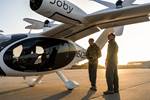






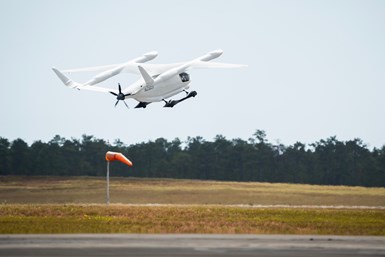















.jpg;maxWidth=300;quality=90)




